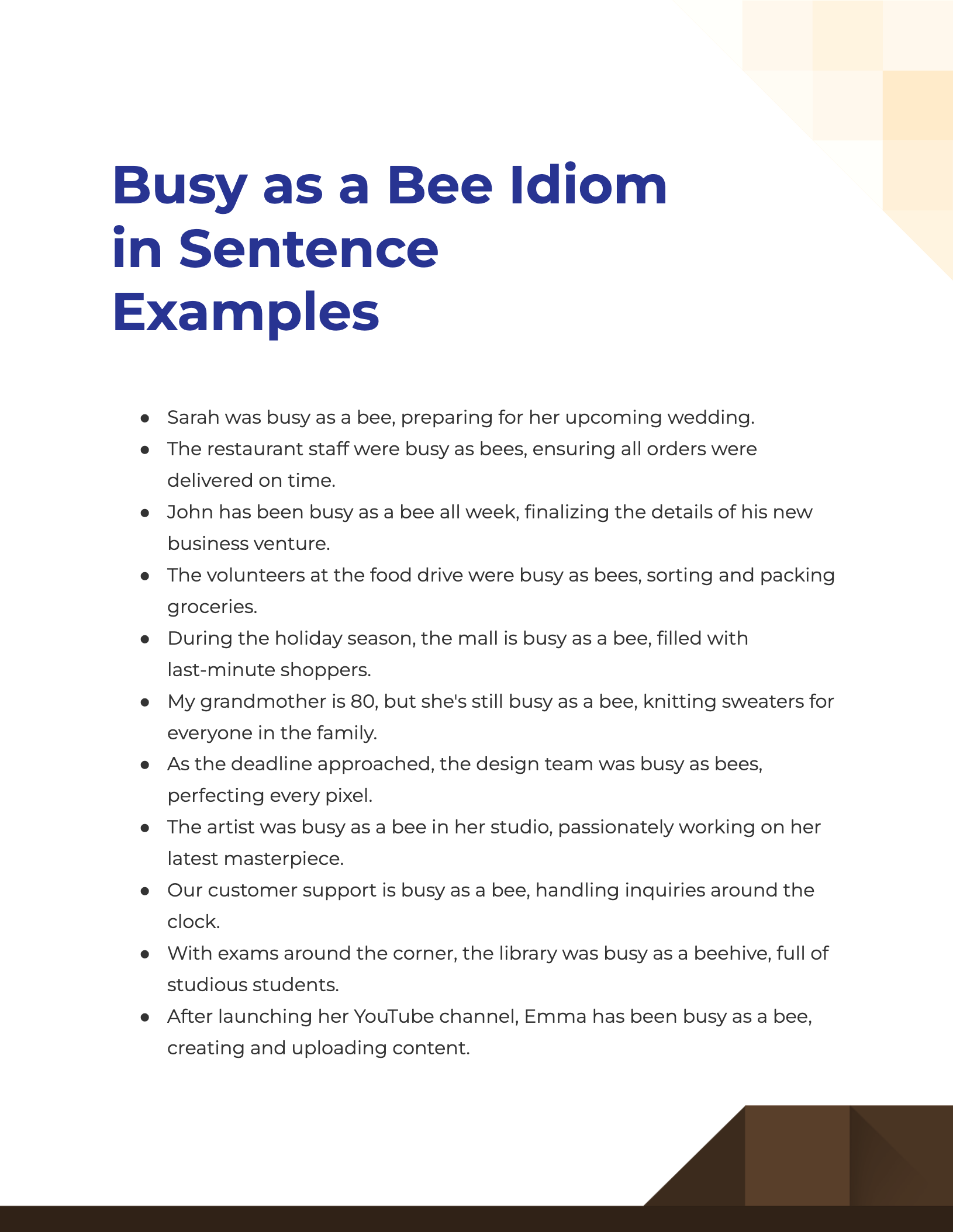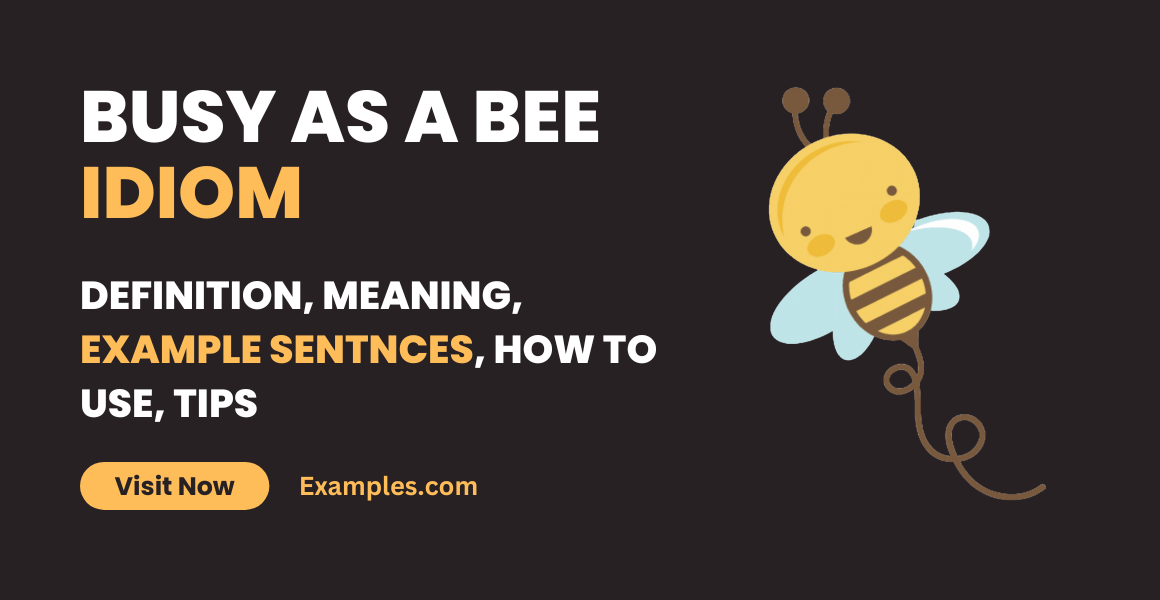19+ Busy as a Bee Idiom Examples
Are you buzzing to elevate your English expressions? Our comprehensive guide on the “Busy as a Bee” idiom is your go-to resource. From its intriguing origin to practical applications, we provide unique sentence examples and expert tips on how to use this examples of idiom to express ceaseless activity or industriousness. Buzz over and dive deep into the world of idioms with us!
What is Busy as a Bee Idiom? – Definition
In straightforward terms, the idiom “Busy as a Bee” describes someone who is very active or hardworking. The phrase is commonly used to indicate that a person is constantly involved in tasks, much like a bee is continually buzzing from flower to flower to collect nectar.
What is the Meaning of Busy as a Bee Idiom? – Detailed Explanation
The idiom “Busy as a Bee” goes beyond its literal interpretation to capture the spirit of constant activity and industriousness. When you say someone is “busy as a bee,” you’re highlighting their relentless effort and commitment to their tasks, similar to how bees tirelessly work to build their hive and make honey. While the expression is often used in a positive context to praise someone’s work ethic, it can also suggest that the person is so busy that they’re almost overwhelmed by their responsibilities.
Origin of Busy as a Bee Idiom
The saying “Busy as a Bee” has deep historical roots, with its earliest recorded use dating back to classical literature. Figures like Geoffrey Chaucer have employed this phrase, which highlights the long-standing human fascination with the industrious behavior of bees. Over the years, the idiom has been adapted and used widely in literature, public speeches, and casual conversations, making it a timeless and versatile way to express the concept of ceaseless activity or diligence.
20 Unique Sentence Examples Using the Idiom “Busy as a Bee”

- Sarah was busy as a bee, preparing for her upcoming wedding.
- The restaurant staff were busy as bees, ensuring all orders were delivered on time.
- John has been busy as a bee all week, finalizing the details of his new business venture.
- The volunteers at the food drive were busy as bees, sorting and packing groceries.
- During the holiday season, the mall is busy as a bee, filled with last-minute shoppers.
- My grandmother is 80, but she’s still busy as a bee, knitting sweaters for everyone in the family.
- As the deadline approached, the design team was busy as bees, perfecting every pixel.
- The artist was busy as a bee in her studio, passionately working on her latest masterpiece.
- Our customer support is busy as a bee, handling inquiries around the clock.
- With exams around the corner, the library was busy as a beehive, full of studious students.
- After launching her YouTube channel, Emma has been busy as a bee, creating and uploading content.
- During the tax season, accountants are as busy as bees, meticulously filing returns.
- The children were busy as bees in the summer camp, participating in various fun activities.
- In preparation for the annual fair, the organizers were busy as bees, coordinating every detail.
- Marcus was busy as a bee, juggling his full-time job and night classes.
- Every morning, the local bakery is busy as a bee, freshly baking goods for the day ahead.
- The tech support team has been busy as bees since the software update was released.
- Our dog has been busy as a bee, digging holes all over the backyard.
- Preparing for her first marathon, Emily has been as busy as a bee, following a rigorous training schedule.
- Since relocating to a new city, Ryan has been busy as a bee, exploring neighborhoods and meeting new people.
More Famous Idioms with Meaning, Sentence Examples
- Play It by Ear Idiom
- In Black and White Idiom
- Crocodile Tears Idiom
- Full of Beans Idiom
- Snake in the Grass Idiom
- Once in a blue moon
- Break a leg Idiom
- Beat around the bush Idiom
- Bite the bullet Idiom
- Through thick and thin Idiom
- Actions speak louder than words Idiom
- Go down in flames Idiom
- Jump on the bandwagon Idiom
- Call it a day Idiom
- It takes two to tango Idiom
- A blessing in disguise Idiom
- Come rain or shine Idiom
- On cloud nine Idiom
- Better late than never Idiom
- Hit the sack Idiom
- Go the extra mile Idiom
- The Whole Nine Yards Idiom
- A penny for your thoughts Idiom
- Pull someone’s leg Idiom
- As right as rain Idiom
- Ignorance is bliss Idiom
- Throw caution to the wind Idiom
- Kick the bucket Idiom
- Take a rain check Idiom
How to Use Busy as a Bee Idiom in Sentences?
Using the idiom “Busy as a Bee” in sentences is straightforward, but understanding the context and the tone can make your usage more impactful. Here are some guidelines:
In Descriptive Context
The idiom is often used descriptively to illustrate someone’s work ethic or level of activity. For example:
- “My sister is busy as a bee, always working on her art projects.”
In Comparative Statements
You can use it in comparative sentences to highlight a busy situation or individual:
- “During the Black Friday sale, the retail staff is busier than a bee.”
Emphasize Activity
This idiom can be used to emphasize ongoing or future activity.
- “I will be as busy as a bee, finishing my assignments this weekend.”
As a Compliment
Sometimes, it’s used to offer a compliment for someone’s hard work:
- “You’ve been as busy as a bee, and the results are fantastic!”
In Narrative Forms
In storytelling, you can use this idiom to describe a character’s attributes or situations:
- “Jane was busy as a bee, preparing her garden for the spring.”
Informal Settings
Remember, the idiom is most suitable for informal or semi-formal settings. It may not be appropriate for formal documents or academic papers.
Tips for Using Busy as a Bee Idiom
Know Your Audience
Understanding your audience will help you decide when this idiom is most effective. If your audience appreciates colloquial language, this is a great idiom to use.
Avoid Overuse
Using it too often can dilute its impact. Make sure to balance idiomatic expressions with straightforward language.
Pair with Imagery
If you’re using this idiom in writing, pairing it with other bee-related imagery can make for a more vivid description.
Use Variations
Feel free to experiment with the structure. Phrases like “busier than a bee” or “busy as a beehive” can convey the same meaning but add a unique twist.
Context Matters
Always ensure that the idiom fits naturally into the context of your conversation or writing. It should flow smoothly and not feel forced.
By following these guidelines and tips, you can use the “Busy as a Bee” idiom to enrich your language, making your conversations and writings more engaging and expressive.



